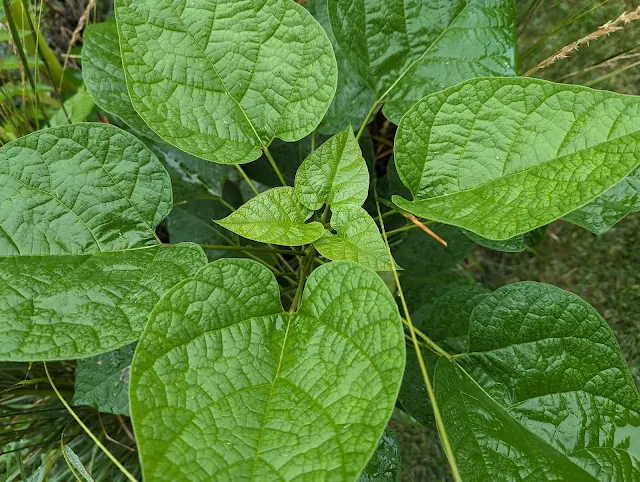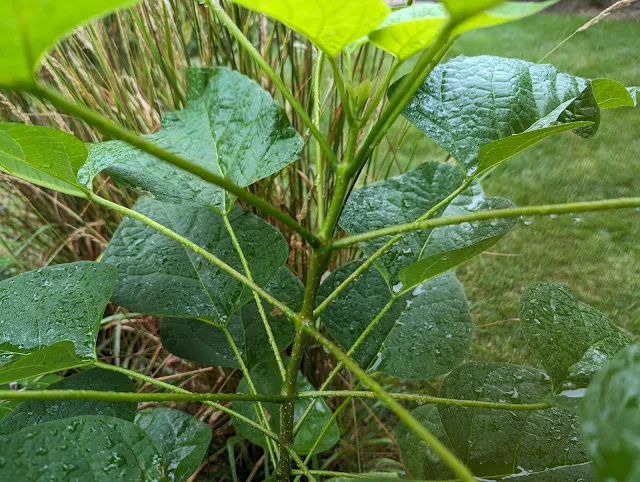Northern Catalpa Two-Year-Old Seedling - September 2023
We have a few large, mature Northern Catalpa trees in our yard that I've really grown to appreciate over the years. They're native trees that have H U G E leaves, put out a really nice set of interesting, white flower blooms on the trees in early Summer, and have a little Fall-show in them with a turn to golden yellow before dropping their large leaves. They leave behind long, lean seed pods that I've tried to grow into seedlings, but I don't think that I've ever successfully sowed a Northern Catalpa tree on my own.
But...they also produce quite a few volunteer trees. In the Fall of 2022, I dug up and transplanted one of those volunteer seedlings and moved it into the little, corner bed of our back patio; tucked in between the Karl Foerster Feather Reed Grasses. I watered it to get it established and then left it alone.
Two years later, what does that little volunteer (transplanted) tree look like? See below for the current state of the tree. It has grown up and put on some size:
A closer look reveals a branching characteristic that confirms (for me) that these are, indeed, Northern Catalpa trees: whorls of three. Here, below are a few shots showing those 'whorls of three' on this Northern Catalpa seedling. First...from the top-down showing the latest whorl-of-three peeking out of the apical meristem or leader. Then, a look under the canopy showing that Northern Catalpa tree triple-branching:This is a two-year-old seedling, so you can expect a 3-to-4-foot-tall Catalpa tree after just two growing seasons. Based on this post on Houzz, I'm seeing the same growth rate that others have in that same two-year span.
The location of this tree is right on the corner of our patio and is a place that I've been thinking of having a tree tucked-in for a number of years. Will it provide some shade on the patio in the next few years? Nope. But, in ten? I'm guessing so.
I've long thought about the concept of miegakure - or 'hide and reveal' as it relates to our backyard. Along with a pond/waterfall/water feature around the patio, creating some sort of a 'room' around our patio with plantings would help pay off that notion of miegakure. This Catalpa tree - as it matures - might be a key piece of the puzzle.This is now the twelfth tree planted (yes...calling this planted despite it being a volunteer) of the year and 89 overall. 12 is the average I've maintained over the years.
We (now) have 63 of 89 trees that we've planted. 70% success rate over seven years.
89 trees planted/7 growing seasons = 12.71 trees on average planted each season
63 trees alive/7 growing seasons = 9.00 trees on average survive each season.
1. Flowering Pear in backyard on north side.
3. Japanese flowering cherry
4 and 5: 2 Lindens that I espalier'd and placed by the south fence line near our kitchen windows.
7. Nat's Saucer Magnolia in our front yard
2018 (17 planted. 6 Dead):
14, 15, 16, 17, 18, 19, 20, 21. These Frans Fontaine Hornbeams.
22. A replacement Chanticleer Pear tree (3" caliper) out front by our garage
25. Our replanted/replacement Dawn Redwood. Same spot as the first.
26. This teeny-tiny Bald Cypress that I planted in the front yard, in between our driveway and our neighbor to the north.
33. My new Weeping White Spruce that will only grow about 4' wide placed near the fence line alongside the espalier'd Lindens.
35. T
46. A small Northern Red Oak tree - our first Oak tree planted.
47. A 'decapitated' Lavender Twist Weeping Redbud that I planted on a whim.
49. A tall(ish) London Plane tree that suffered some transplant and frost shock, but seemed to recover.
1. [This says 'planted', but there are two volunteers on here that aren't 'technically' planted in 2023, I just counted them in 2023.]↩







Comments
Post a Comment
Be nice to each other here.